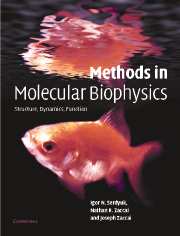Book contents
- Frontmatter
- Contents
- Foreword by D. M. Engelman
- Foreword by Pierre Joliot
- Preface
- Introduction: Molecular biophysics at the beginning of the twenty-first century: from ensemble measurements to single-molecule detection
- Part A Biological macromolecules and physical tools
- Part B Mass spectrometry
- Part C Thermodynamics
- Part D Hydrodynamics
- Chapter D1 Biological macromolecules as hydrodynamic particles
- Chapter D2 Fundamental theory
- Chapter D3 Macromolecular diffusion
- Chapter D4 Analytical ultracentrifugation
- Chapter D5 Electrophoresis
- Chapter D6 Electric birefringence
- Chapter D7 Flow birefringence
- Chapter D8 Fluorescence depolarisation
- Chapter D9 Viscosity
- Chapter D10 Dynamic light scattering
- Chapter D11 Fluorescence correlation spectroscopy
- Part E Optical spectroscopy
- Part F Optical microscopy
- Part G X-ray and neutron diffraction
- Part H Electron diffraction
- Part I Molecular dynamics
- Part J Nuclear magnetic resonance
- References
- Index of eminent scientists
- Subject Index
- References
Chapter D8 - Fluorescence depolarisation
from Part D - Hydrodynamics
Published online by Cambridge University Press: 05 November 2012
- Frontmatter
- Contents
- Foreword by D. M. Engelman
- Foreword by Pierre Joliot
- Preface
- Introduction: Molecular biophysics at the beginning of the twenty-first century: from ensemble measurements to single-molecule detection
- Part A Biological macromolecules and physical tools
- Part B Mass spectrometry
- Part C Thermodynamics
- Part D Hydrodynamics
- Chapter D1 Biological macromolecules as hydrodynamic particles
- Chapter D2 Fundamental theory
- Chapter D3 Macromolecular diffusion
- Chapter D4 Analytical ultracentrifugation
- Chapter D5 Electrophoresis
- Chapter D6 Electric birefringence
- Chapter D7 Flow birefringence
- Chapter D8 Fluorescence depolarisation
- Chapter D9 Viscosity
- Chapter D10 Dynamic light scattering
- Chapter D11 Fluorescence correlation spectroscopy
- Part E Optical spectroscopy
- Part F Optical microscopy
- Part G X-ray and neutron diffraction
- Part H Electron diffraction
- Part I Molecular dynamics
- Part J Nuclear magnetic resonance
- References
- Index of eminent scientists
- Subject Index
- References
Summary
Historical review
1926
E. Gaviola created the first instrument for fluorescence measurement, which he called a fluorometer.
1934
F. Perrin formulated the relation between fluorescence depolarisation and Brownian rotary motion for hydrodynamic spherical molecules. In 1936 he extended his treatment to symmetric top molecules.
1952
G. Weber first applied Perrin theory to biological macromolecules. Numerous fluorescence polarisation measurements were carried out under steady-state conditions, utilising constant illumination. Most of them were performed on dye-conjugated macromolecules to determine the harmonic mean rotational relaxation time. Weber's classical review of the application of polarised fluorescence, particularly to proteins, appeared in the 1950s.
1961
A. Jublonski proposed following the rotational relaxation process directly by measuring the decay of the fluorescence polarisation as a function of time. He stressed that time-dependent anisotropy can be interpreted more directly and definitely than its time-average value observed with constant illumination.
1966
P. Wahl, and two years later L. Stryer, experimentally measured the time decay of fluorescence polarisation on dye-conjugated globular proteins.
1969
T. Tao derived relations between the time-dependent fluorescence polarisation anisotropy and the Brownian rotational diffusion coefficients of macromolecules. It was shown that in the most general case of a completely asymmetric body, five exponentials appear in anisotropy. In 1972 analogous results were obtained by other groups (G. G. Belford, R. L. Belford and G. Weber; T. J. Chuang and K. B. Eisenthal).
- Type
- Chapter
- Information
- Methods in Molecular BiophysicsStructure, Dynamics, Function, pp. 446 - 465Publisher: Cambridge University PressPrint publication year: 2007



